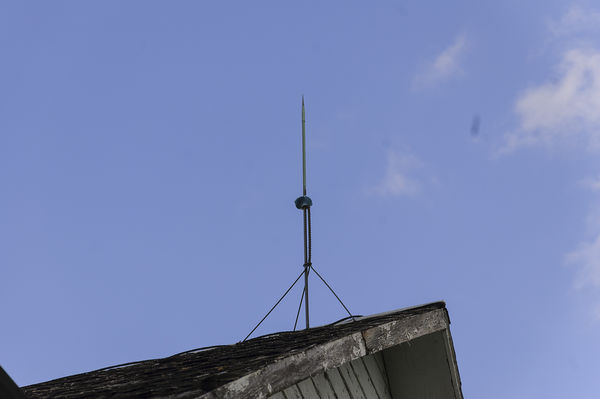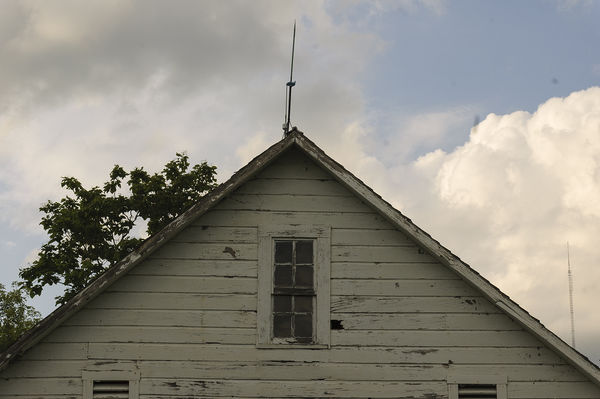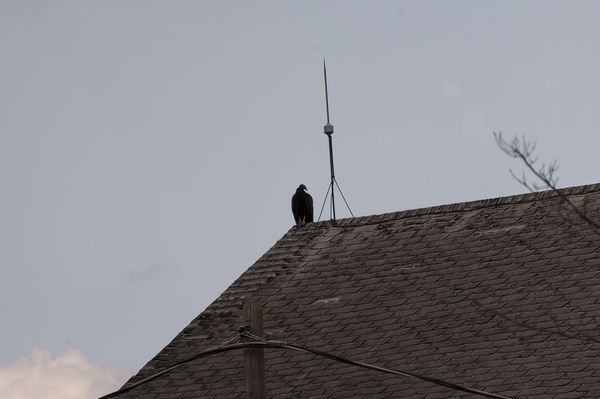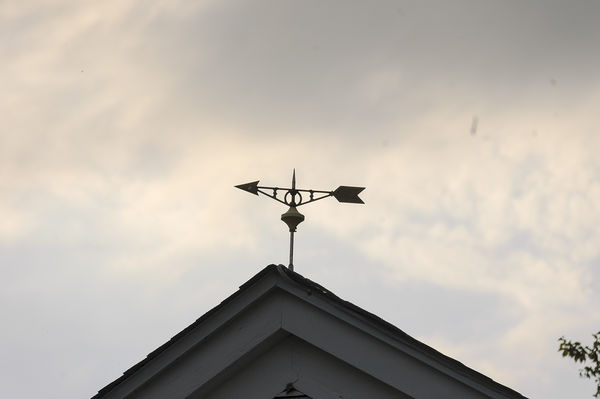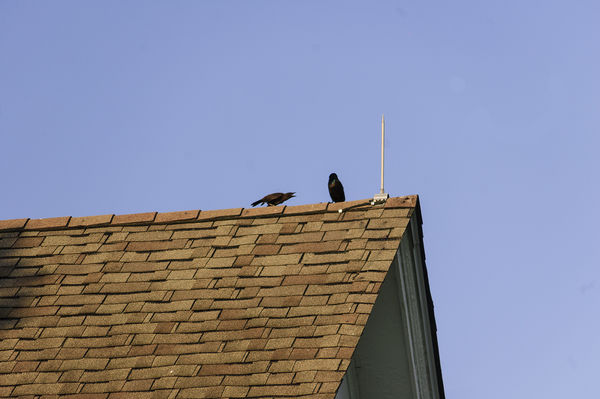Lightening Rods
Jun 25, 2017 06:55:53 #
Taking an evening walk around an unoccupied farm. Nikon D70 with a Tamron 18-200 lens. Looks like there is some junk on the sensor. It's fine walk around camera, though I don't use it much, but it was fun taking it out for a walk. I don't think it is ready for permanent retirement so a trip to the shop is in the future.
The last picture is an adult black bird with a hungry juvenile that is begging for food. It looks like it is grown enough to feed itself, but maybe not.
Ken
The last picture is an adult black bird with a hungry juvenile that is begging for food. It looks like it is grown enough to feed itself, but maybe not.
Ken
Jun 25, 2017 06:57:23 #
Jun 25, 2017 07:27:33 #
The juveniles are so used to getting food from their parents. I watched a pair of juvenile - fully fledged - woodpeckers sitting on a branch 2 feet from the suet feeder, begging loudly as mom went back and forth to the feeder to get suet to feed them. Pretty silly.
Interesting set on lightning rods. I grew up in Kansas and they were a pretty common fixture. I know there was always discussion about whether or not they worked. I don't see them used anymore - except - the shelters at some of the amusement parks in Orlando have them. I have to wonder if a well-grounded lightening rod on top of a tall structure doesn't invite problems..... Interesting to hear from fellow hoggers about this "burning" issue...
Interesting set on lightning rods. I grew up in Kansas and they were a pretty common fixture. I know there was always discussion about whether or not they worked. I don't see them used anymore - except - the shelters at some of the amusement parks in Orlando have them. I have to wonder if a well-grounded lightening rod on top of a tall structure doesn't invite problems..... Interesting to hear from fellow hoggers about this "burning" issue...
Jun 25, 2017 07:30:57 #
Jun 25, 2017 08:02:38 #
They work, but they have to be hooked up right. When I replaced the roof with metal, on my 1880 farmhouse, I took the set of three with the cable harness down and laid them on the lawn. They are connected in series with a copper cable. The cable runs the length of the roof and down each end to a buried ground rod. I set them back up with the cable all connected when the roof was finished. Lightning occurs with an overabundance or imbalance of positive and negative ions in the atmosphere (I may be corrected on that). The purpose of the lightning rod hook-up is to bring that charge near the house to ground before a discharge or lightning strike occurs. It protects the immediate vicinity of the house. Lightning does not actually strike the lightning rod if it is properly grounded. The glass balls you sometime see are just for decoration. I have mine and they have turned lavender from sunlight exposure over the years. Sorry for a pedantic explanation, but I'm kind of enthused about this old technology. :)
Jun 25, 2017 08:04:16 #
My mother said she always wondered about the empty nest feeling mothers have when the kids all leave--hers kept coming back. And they brung more with 'em.
Personally, I don't see how a flimsy rod attracting lightening would be good for the house. I saw a long, ranch-style house hit by lightening in the center, and the whole middle of the house was gone.The power is too great to ground it that way through a mere wire. On tall buildings, though, the rods connect to the steel superstructure and they have been photographed grounding the lightening perfectly. When I was a child, we saw in our social studies book a photo of lightening hitting the Empire State Building with no harm done. It was taken at night with shutter open on B setting during a storm. Now such pictures are common.
Airplanes are another matter and it is a mystery to me how they survive regular lightening hits. In 1967, an airliner exploded when lightening hit the fuel tank, so they adopted methods of keeping the lightening on the outside aluminum skin--when charged, the plane is the source of a lightening bolt rather than the target. Of course, most of the flights are above the storms.
https://www.scientificamerican.com/article/what-happens-when-lightni/
Personally, I don't see how a flimsy rod attracting lightening would be good for the house. I saw a long, ranch-style house hit by lightening in the center, and the whole middle of the house was gone.The power is too great to ground it that way through a mere wire. On tall buildings, though, the rods connect to the steel superstructure and they have been photographed grounding the lightening perfectly. When I was a child, we saw in our social studies book a photo of lightening hitting the Empire State Building with no harm done. It was taken at night with shutter open on B setting during a storm. Now such pictures are common.
Airplanes are another matter and it is a mystery to me how they survive regular lightening hits. In 1967, an airliner exploded when lightening hit the fuel tank, so they adopted methods of keeping the lightening on the outside aluminum skin--when charged, the plane is the source of a lightening bolt rather than the target. Of course, most of the flights are above the storms.
https://www.scientificamerican.com/article/what-happens-when-lightni/
Jun 25, 2017 08:16:26 #
Jun 25, 2017 08:17:15 #
Charles 46277 wrote:
My mother said she always wondered about the empty... (show quote)
You're right Charles, it wouldn't absorb a direct lightning strike. That's not the point. It grounds the ions before the strike occurs at that location. Mine have been on this house for probably 100 years. They've been around since Ben Franklin. I also wonder about the surrounding topography. A farmhouse on the open plains might be the tallest target around for miles. 100 years ago, my house would have been on open land. Now I'm surrounded by 60-foot maple trees. And thunder and lightning storms are common around here.
Jun 25, 2017 08:19:28 #
Perhaps the copper wires you used carry charges from the ground into the charged air--the lightening goes from the house to the sky, as in most airplane strikes when the planes become charged in a storm. In this case, the wires might carry only so much lightening as they can transmit--harmlessly. The reverse lightening (sky to ground) could be much greater. In that case, the lightening bolt is liable to destroy copper wires and spark outwards to seek additional grounding from house plumbing, wiring, and other metal--which it would not do in a skyscraper with columns of solid steel for grounding. I would not want to tempt lightening bolts with wires, like a bullfighter waving a red cape. Big trees, drenched in water in a storm, might make fair lightening rods, if not too close to the house. Or they could be wired? John Kennedy once said, "The world is a dangerous place."
Jun 25, 2017 08:22:48 #
They are meant to bleed off any differential static charge that may be built up between the ground and the clouds. Static charges bleed off faster from a point (as opposed to a large surface).
Jun 26, 2017 06:04:10 #
Jun 26, 2017 16:07:25 #
DonB
Loc: Port Royal , Tn
In Lexington Va. there is a graveyard with a lot of the Confederacy War leaders interred. Some of the huge trees over the graves have lighting rods installed. If they are installed AND maintained properly, they work. They are not install and forget.
Jun 26, 2017 23:09:07 #
If you want to reply, then register here. Registration is free and your account is created instantly, so you can post right away.

